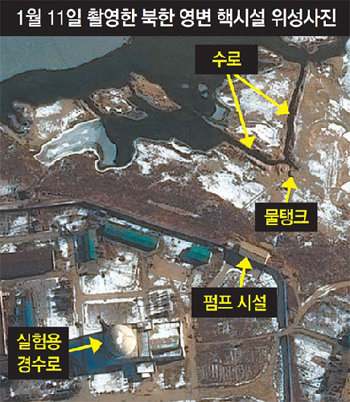N. Korea`s Yongbyun light water reactor edges closer to becoming operational
N. Korea`s Yongbyun light water reactor edges closer to becoming operational
Posted January. 16, 2016 10:09,
Updated January. 19, 2016 13:57

Following the fourth nuclear test, North Korea has started the final construction of the experimental light water reactor, or ELWR, at the Yongbyun nuclear facility in North Pyongan Province, according to the U.S. on Thursday.
"38 North," a website dedicated to North Korean issues operated by U.S. Korea Institute at Johns Hopkins University SAIS, said that after an analysis of the commercial satellite imagery taken on Monday after the nuclear test, the North has seen significant advances in the ELWR and is ready for its operation.
According to 38 North, recent commercial satellite imagery indicates that the ELWRs cooling system has been made functional with the construction of two channels through a sand bar that allow river water to flow into a cistern critical for the operation of the reactors cooling system. It added that the North also installed two transformers for supply of power to the nuclear reactor. Prior to this, the North built a new facility near the ELWR in June last year that appears to be built to support transformers and power supply facilities.
38 North also said while it is difficult to predict when the light water reactor will be completed and start operation, it will be able to produce raw materials for manufacturing nuclear weapons once realized. The U.S. Federation Of American Scientists has predicted that when this reactor is completed the North will be able to produce 30-40 kilograms of plutonium additionally that can make five to six nuclear weapons annually.
The U.S. Institute for Science and International Security also said that by analyzing the commercial satellite photo, it was found that North Korea is operating the 5 megawatt graphite decelerator intermittently at the Yongbyun nuclear facility, while continuously operating a centrifuge for uranium compression. David Albright, founder of the non-governmental Institute for Science and International Security in Washington, said the photo taken last year showed hot water coming out of the nuclear reactor, but the latest photo didn`t show hot water, adding that this is because the North operated the graphite decelerator intermittently. He also estimated that the centrifuge is steadily being operated given that there was no snow on the roof of the centrifuge building and two assisting buildings (while other nearby buildings had snow on their roof).
ddr@donga.com







